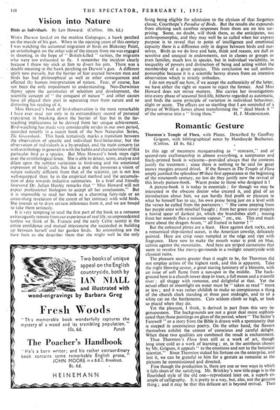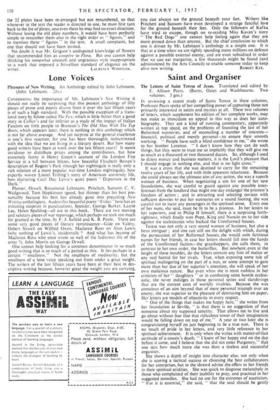Romantic -Gesture
Thornton's Temple of Flora, with Plates. Described by Geoffrey Grigson, with bibliographical notes by Handasyde Buchanan. (Collins. £8 8s. Od.)
IN this age of meanness masquerading as " restraint," and of second-rate craftsmanship in almost everything, a sumptuous and finely-printed book is welcome—provided always that the contents justify the treatment ; since there is nothing to be said for great snowy margins around drivel. If the flowers in The Temple of Flora amply justified the splendour trf their first appearance at the beginning of the nineteenth century, no less do they justify now the revival of this lovely picture-book. Warm praise to those who designed it !
A picture-book it is today in essentials ; for though we may be interested in the obscure doctor who created it, and glad of an introduction about him, we can hardly find profit or pleasure in what he himself has to say, his own prose being just on a level with the verses he culled from the poetasters : " She came peeping from her purple crest with mischief fraught ; from her green cover projects a horrid spear of darkest jet, which she brandishes aloft ; issuing from her nostrils flies a noisome vapour," etc., etc. This and much more about the dragon Arum," all framed in horror ! "
But the coloured plates are a feast. Here against dark rocks, and a romantical ship-slanted ocean, is the American cowslip, delicately painted. Here are crisp roses rumpled at the edge and ripe with fragrance. Here now to make the mouth water is pink on blue, calmia against the mountains. And here are striped carnations that seem to revolve like merry-go-rounds in a twilight countryside with classical ruins.
The pleasure seems greater than it ought to be, for Thornton did not employ artists of the highest rank, and this is apparent. Take the night blowing cereus, a great staring luminary of a blossom, with an issue of soft flame from a sun-spot in the middle. The back- ground here is a church-tower deep in trees, a full moon and a moonlit river : all shaggy with romance, and delightful at that. Yet the actual effect of moonlight on water must be "taken as read" more or less ; and it was rather childish to make so conspicuous a thing of the church clock standing at three past midnight, and to sit a white cat on the battlements. Cats seldom climb so high, or look so placid when they do.
Yet the pleasure, I think, is derived in part from this very in- genuousness. The backgrounds are not a great deal more sophisti- cated than those paintings on glass of the period, where" The Sailor's Farewell " or a story from the Bible is drawn with a spontaneity that is steeped in unconscious poetry. On the other hand, the flowers themselves exhibit the utmost of conscious and careful delight. When these two qualities are combined the result is enchantment.
Thus Thornton's Flora lives still as a work of art, though long since cold as a work of learning ; or, in the antithesis chosen by Mr. Grigson, it appeals" to the emotions and not to the botanical scientist." Since Thornton staked his fortune on the enterprise, and lost it, we can be grateful to him for a gesture as romantic as the pictures he commissioned and directed.
Fine though the production is, there are one or two ways in which it falls short of the satisfying. Mr. Brinkley's new title-page is in the flourished style of the old one—reproduced later on, a superb ex- ample of calligraphy. It is pretty in a way, but, alas, not the genuine thing ; and it may be that this delicate art is beyond revival. Then
the 32 plates have been re-arranged but not renumbered, so that whenever in the text the reader is directed to one, he must first turn back to the list of plates, and even there he may find no exact direction. Without losing the old plate numbers, it would have been perfectly simple to renumber them also in the right order as " figures," and to mention these " figures " in the text. A small complaint, but one that should not have been invited.
No doubt it was Mr. Grigson's undisputed knowledge of flowers that recommended him as cotnpere to Flora. But one cannot help thinking his somewhat uncouth and ungracious style inappropriate to a work that imposed a Sitwellian standard of elegance on the



































 Previous page
Previous page